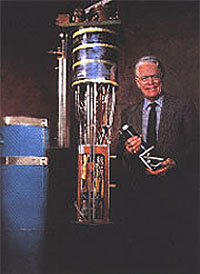
by Jeffery Kahn

|
| Paul Richards stands with elements of the Woody/Richards cosmic microwave background instrument package, an historic balloon-borne experiment that now resides in the Smithsonian Museum's permanent national collection. |
Dave DeVorkin, the museum's curator for the history of astronomy, is spearheading the proposal to extend the museum to include the human quest to investigate and understand the cosmos. Berkeley Lab has a significant role in this story, says DeVorkin.
"At this stage," DeVorkin says, "I am collecting objects that are worthy of permanent preservation in the national collection, objects that have played a prominent role in the history of astronomy. They would be displayed in a proposed new gallery to be constructed here. The gallery would explore cosmology back to the beginning of human curiosity. Its working title is "'Explore the Universe.'"
In recent months, DeVorkin has contacted two Berkeley Lab scientists, Material Sciences Division's Paul Richards, and Physics Division's George Smoot. Both Richards and Smoot led scientific teams that made seminal discoveries about the early universe. The two scientists have made their mark studying the cosmic microwave background, the remnant radiation from the Big Bang that suffuses space.
Paul Richards led a group that, in the 1970s, performed balloon-borne experiments that provided compelling evidence that the cosmic microwave background radiation is a blackbody spectrum.
When something is hot, it emits electromagnetic radiation. For every temperature, there is a unique and corresponding distribution of wavelengths and frequencies known as the blackbody spectrum, even for something as hot as the Big Bang.
Says Richards, "At a time when there was significant uncertainty, our data showed that the early universe was a blackbody. It documented that the universe was not a steady state (in which matter is continuously created and formed into new galaxies.) Instead, this was the strongest possible evidence for the Big Bang origin of the radiation."
Richards recalls that it was Nobel laureate Charles Townes who first involved him in astrophysics. Townes was always interested in the big questions of the day and was aware that the existing measurements of the spectrum of the background radiation showed large deviations from a blackbody spectrum.
Says Richards, "I was a condensed matter physicist in the Inorganic Materials Research Division at the Lab with an expertise in using infrared spectroscopy to probe the properties of matter. Townes approached me to say that he believed I had the best technology for measuring the temperature of higher frequency cosmic microwave background. He guessed, correctly it turned out, that we already had the building blocks to do this science."
Richards joined with two graduate students, John Woody and John Mather. By 1974, they had built an apparatus that consisted of an antenna, spectrometer, and detector, all cooled by liquid helium to a temperature below 3 Kelvin. Beginning in 1973, this balloon-borne apparatus made a number of flights. For the next 15 years the results of these flights provided the best evidence available that the background radiation indeed was a blackbody.
Richards was recently awarded the Button Medal and Prize from the Institute of Physics in Great Britain for his lifetime contributions to the science of the electromagnetic spectrum. Now elements of what came to be known as the Woody/Richards experiment have joined the Smithsonian's permanent collection.
Smoot's most significant contribution was made through the use of the exquisitely sensitive microwave receivers created for NASA's Cosmic Background Explorer (COBE) satellite, with which he detected fossil relics from the primeval explosion that began the universe. From Smoot, DeVorkin chose two microwave receivers -- known as Differential Microwave Radiometers -- to make a part of the Smithsonian's permanent collection.
While DeVorkin says it is too early to know if the Smithsonian's director will grant approval and funds for "Explore the Universe," the objects from Richards and Smoot will remain part of the national collection and will be available for future exhibit both here and for loan to other museums.
 RETURN TO TABLE OF CONTENTS
RETURN TO TABLE OF CONTENTS